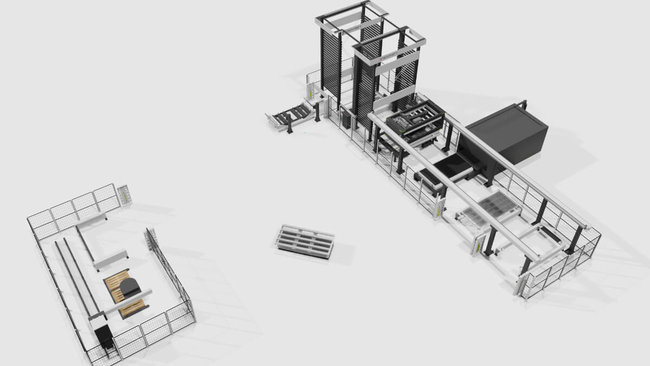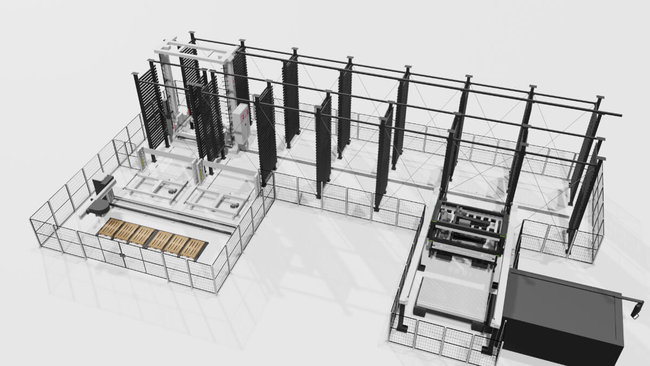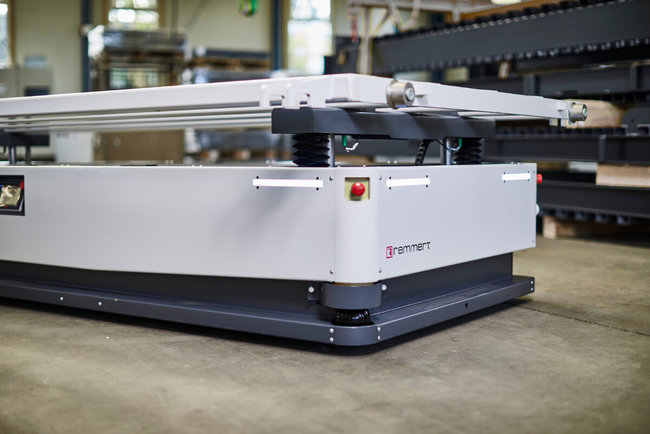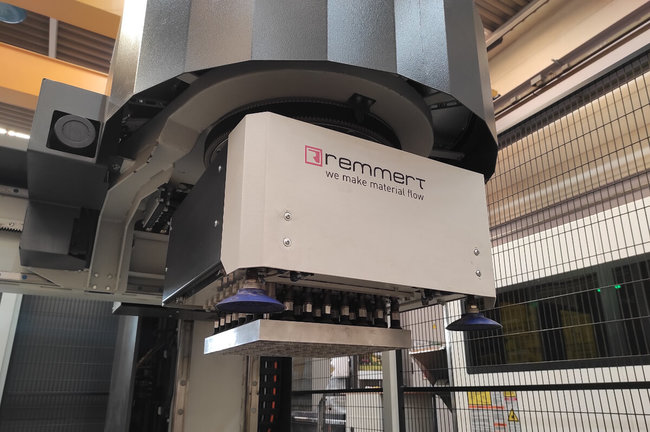Fibre laser cutting systems have revolutionised sheet metal processing and set the pace in production. With the powerful machines, the speed at which the sheets can be filleted by fully automatic systems is higher than the sheet change possible with a manually controlled crane or forklift. When humans become the limiting factor of overall equipment effectiveness (OEE), automatic sheet metal storage with automated lines come into play. They supply the laser machines with their horizontally traversing gantry robots: Rakes remove lasered metal sheets from the changing tables, and vacuum suction device add raw metal sheets. In this way, a laser cutting machine can in principle operate around the clock as long as the material flow before and after it functions smoothly. What is still usually done by hand today can also be automated. Provided that there is enough space.
Rigid automation lines cause space issues
“The compulsory linking of laser and storage via automation takes up a considerable amount of space, especially when more than one laser is connected to the automation system. This works well when planning on a greenfield site. In existing properties, the entire hall often has to be moved, if this is even possible at all,” says Johannes Dippner, Area Sales Manager at Remmert GmbH, describing the situation that many of his customers face. Remmert is a manufacturer of storage and automation technology for handling sheet metal and long goods and specialises in individual solutions and the integration of various machine manufacturers.
SMEs in particular would have to overcome challenges in this regard in order to implement the desired capacity increases in the existing stock. “Often there is only space for a single storage tower in addition to the laser. This is sufficient to continuously feed a single machine with replenishment or to buffer cut sheets. For crisis-proof storage with unfinished metal sheets, if possible, additional storage space must be maintained at another location in the company, including shuttling with forklifts across the company alongside the corresponding personnel costs”, says Dippner.
Automated guided vehicles for shuttling sheet metal
For such scenarios, Remmert has developed an automated guided vehicle system that is adequately dimensioned for the transport of large and heavy metal sheets and can nevertheless safely navigate even in narrow driving distances. For this purpose, the vehicle must be able to navigate freely, to recognise obstacles independently and to master omnidirectional driving. “Our AGV can turn in place, drive forwards, backwards and sideways. As a result, we are also able to drive to goods transfer stations longitudinally or transversely,” says Dippner, explaining the mobility of the Remmert AGV. The company, based in Löhne in East Westphalia, Germany, sees potential applications in the transport of sheet metal packages between laser centres and central sheet metal warehouses, as well as in the removal of cut sheet metal panels after laser cutting. “The great advantage is the high level of flexibility for achieving proper spatial organisation in the plant. Machining centres and storage can be placed more freely and approached on an order-related basis. In addition, the sorting and palletising of laser-cut workpieces no longer necessarily has to be carried out in the vicinity of the lasers”.
Decentralised palletising robot is supplied by the AGV
The manual sorting of sheet metal parts is a labour-intensive process, and above all an ergonomically unfavourable one. Staff must sometimes reach far into the table to lift heavy metal parts. Conveyor belts can provide support here, but the effort on the part of the staff remains. The first robotics applications are already taking on this thankless job. Remmert also has a palletising robot with an automatic changing tool for different formats in its range. The robot first scans the position of the sheet metal panels and uses the cutting plan to pick up the individual workpieces by use of a vacuum suction device or magnet and stacks them on pallets prepared for this purpose.
Whether manually or automatically – the heretofore common practice has been to sort and palletise directly next to the laser machine, often even directly from the automation line. “Given the speed of the lasers, this must happen very quickly and error-free. Finally, the changing table must be free before the next metal sheet comes out of the laser. It can then become quite demanding, especially with variant-rich cutting plans or heavy workpieces. In addition, it happens again and again that workpieces tilt on the cutting table or get stuck on the residual material grid after the laser treatment. In this case, too, humans must be present at the robot,” says Dippner, explaining the challenges.
Here, a decentralised sorting station supplied by an AGV can be an interesting alternative. “This is also ideal if more than one laser is being operated. The AGV drives to the laser centres based on the order, picks up the cut sheet and takes it to the sorting station, which can be anywhere else. In this way, subsequent processing steps such as grinding and deburring the workpieces could also be mated to the sorting station in a manner that makes sense for the space”.



